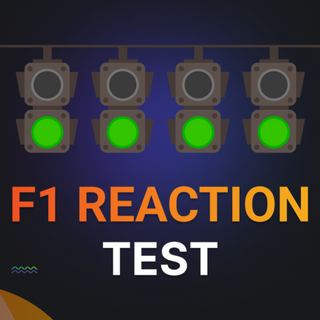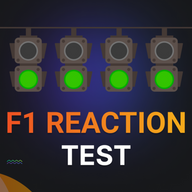
F1 Reaction Test
Reaction time is the interval between a stimulus (like lights going out) and your response. In F1 racing, elite drivers achieve reaction times between 150-220ms. The average F1 driver reaction time is significantly faster than the average human reaction time of around 250ms. Your reaction time will be measured in milliseconds - the lower the better! This F1 reaction test helps you measure and improve your reaction speed in a racing context.
Understanding F1 Driver Reaction Time in Racing
Reaction time is a critical factor in Formula 1 racing, especially at the start of a race. The F1 reaction timer measures what different reaction times mean in the context of F1 racing and how you compare to professional drivers. Top drivers can achieve an incredible 0.133 reaction time in crucial race moments.
Reaction Time Categories
Elite (150-180ms)
This is the realm of F1 champions. Drivers like Lewis Hamilton, Max Verstappen, and Fernando Alonso consistently achieve reaction times in this range on F1 reflex tests. If you score in this category, you have reflexes comparable to the world's best racing drivers. The current F1 record for race starts is held by Valtteri Bottas, who achieved a 0.201 second reaction at the 2017 Austrian Grand Prix, approaching the theoretical best of 0.133 reaction time.
Professional (181-210ms)
This range represents excellent reaction times achieved by professional racing drivers and elite athletes on reaction time test F1 simulations. Most F1 drivers operate in this range consistently. If you score here on our F1 reaction timer, you have the potential for professional-level performance in reaction-based activities.
Advanced (211-250ms)
This is better than average and represents good reflexes on an F1 reflex test. Many amateur racing drivers and experienced gamers achieve times in this range. With practice on F1 reaction tests, you can improve from this level to the professional category.
Average (251-300ms)
This is the typical reaction time for healthy adults under optimal conditions, well above the average F1 driver reaction time. Most people's first attempts at F1 reaction tests fall into this category. Don't worry if you're here - with practice, your times on the reaction time test F1 simulation can improve significantly.
Below Average (301-350ms)
Slightly slower than average, but still within normal range for non-professionals. Factors like fatigue, distraction, or lack of practice can contribute to scores in this range on an F1 reaction timer. Regular practice with F1 reflex tests can help improve these times.
Slow (351ms+)
Reaction times in this range may indicate fatigue, distraction, or simply a need for more practice with F1 reaction tests. In an F1 context, this would result in a poor start and likely losing positions. Don't be discouraged - everyone starts somewhere, and consistent practice with reaction time test F1 simulations can lead to significant improvements toward the elite 0.133 reaction time benchmark.
Factors Affecting Reaction Time
Age
F1 driver reaction time typically peaks in your 20s and gradually slows with age. F1 drivers often peak in their late 20s to early 30s, balancing peak reaction time with experience on the track.
Fatigue
Tiredness can significantly impact reaction time on F1 reflex tests. F1 drivers undergo intensive physical training to maintain focus and quick reactions even during grueling races lasting over 2 hours, helping them maintain their exceptional reaction time test F1 results.
Practice
Regular practice with an F1 reaction timer can improve reaction time by strengthening neural pathways. F1 drivers spend countless hours practicing starts to develop muscle memory and optimize their reactions, some achieving the coveted 0.133 reaction time in critical race moments.
Distractions
External distractions can slow reaction time on F1 reflex tests. F1 drivers learn to filter out the noise of engines, crowds, and team radio to focus solely on the starting lights, maintaining their exceptional average F1 driver reaction time.
How to Improve Your F1 Reaction Time
Regular practice with F1 reaction timer tests like this one can help improve your neural pathways and response speed, getting you closer to the elite 0.133 reaction time of top drivers.
Ensure you're well-rested before taking an F1 reflex test - fatigue significantly impacts performance and can add precious milliseconds to your reaction time.
Maintain good physical fitness like real F1 drivers - studies show that regular exercise improves overall reaction time and helps you achieve better results on reaction time test F1 simulations.
Stay hydrated and maintain proper nutrition - your brain needs proper fuel to function optimally and achieve the best possible F1 driver reaction time.
Practice mindfulness techniques to improve focus and reduce distractions when performing reaction-based tasks.
Historical Background
The Evolution of Formula 1
Formula 1 represents the pinnacle of motorsport technology, driver skill, and racing heritage. Understanding its rich history helps appreciate why the F1 reaction test is so significant in the context of racing and why drivers strive for the perfect reaction time test F1 performance.
Formula 1, the pinnacle of motorsport, began in 1950 with the first World Championship race at Silverstone, UK. Over seven decades, it has evolved from a dangerous gentleman's sport into a high-tech global phenomenon combining cutting-edge engineering, athletic excellence, and strategic brilliance.
Today's F1 start sequence is one of the most tense moments in sports, with drivers balancing on the edge of perfect reactions and costly false starts. Modern F1 cars can accelerate from 0-100 km/h (0-62 mph) in approximately 2.6 seconds, making the F1 reaction test absolutely critical. Drivers with exceptional F1 reflex test results often gain crucial advantages that can determine race outcomes.
The Birth of Formula 1 (1950s)
Formula 1 officially began in 1950 with the first World Championship race at Silverstone, UK. The inaugural season featured just seven races, with Italian Giuseppe Farina becoming the first World Champion driving an Alfa Romeo. In these early days, races began with drivers running to their cars (Le Mans start) or with a flag-waving official. F1 driver reaction time was important, but not measured with the precision of today's electronic F1 reaction timer systems that can detect differences down to 0.001 seconds.
The Evolution of Race Starts (1960s-1970s)
Throughout the 1960s and early 1970s, F1 races typically began with a flag start. The starter would raise the national flag of the host country, and drivers would prepare to launch when the flag dropped. This system was inherently subjective and sometimes controversial, as drivers at the back of the grid might not clearly see the flag drop. The 1970s saw increased safety measures following several fatal accidents, including Jackie Stewart's campaign for driver safety.
Introduction of Starting Lights (Late 1970s)
The electronic starting light system was introduced in the late 1970s, revolutionizing race starts. This system featured a sequence of red lights that would illuminate and then extinguish to signal the start. This standardized the starting procedure across all circuits and eliminated the human variability of flag starts. For the first time, all drivers could see exactly the same signal regardless of their grid position.
Modern Era and Technology (1990s-Present)
The 1990s saw further refinement of the starting light system and the introduction of sophisticated launch control systems in F1 cars. These electronic aids could optimize clutch engagement and wheelspin, producing perfect starts every time.
However, to place greater emphasis on driver skill, the FIA banned launch control in 2004. Today's F1 start procedure features five red lights that illuminate sequentially at one-second intervals. After a random delay of 0.2-3 seconds, all lights extinguish simultaneously, signaling the race start.
Legendary Drivers Known for Their Starts
Michael Schumacher
Michael Schumacher: The seven-time world champion was renowned for his exceptional starts, often gaining multiple positions in the first few seconds of a race. His F1 driver reaction time was consistently among the best, and his ability to judge the exact moment the lights would go out gave him a crucial advantage.
Ayrton Senna
Ayrton Senna: The Brazilian legend had almost supernatural reflexes, with measured reaction times as low as 0.2 seconds, far better than the average F1 driver reaction time. His intense focus during F1 reaction tests and at the start of races often translated into immediate advantages.
Fernando Alonso
Fernando Alonso: Known for his lightning-quick reactions and aggressive first-lap strategy, Alonso has demonstrated throughout his career an exceptional F1 reflex test performance and an ability to make up positions at the start regardless of his qualifying position.
Lewis Hamilton
Lewis Hamilton: The seven-time champion combines exceptional reaction time with strategic race craft. His F1 reaction time is reportedly close to the elite 0.133 reaction time benchmark, and his ability to make perfect starts under pressure has contributed significantly to his success.
Famous F1 Starts in History
1998 Belgian Grand Prix: One of the most chaotic starts in F1 history saw a massive 13-car pile-up in wet conditions at the first corner, triggered by David Coulthard's McLaren spinning. The race was restarted with many drivers switching to spare cars (a practice no longer allowed).
2016 Spanish Grand Prix: Mercedes teammates Lewis Hamilton and Nico Rosberg collided dramatically at the start, taking both cars out of the race and setting up Max Verstappen for his first F1 victory at just 18 years old.
1979 French Grand Prix: Gilles Villeneuve and René Arnoux engaged in one of F1's most legendary battles following an intense start, showcasing the importance of position gained at lights out.
2001 Malaysian Grand Prix: Michael Schumacher and his Ferrari teammate Rubens Barrichello executed a perfect start in wet conditions, moving from 1st and 3rd on the grid to be 4 seconds ahead of the field by the end of lap 1.
2015 Japanese Grand Prix: Max Verstappen stalled on the grid but managed to get his car restarted just as the lights went out, avoiding a potential disaster and showcasing the pressure drivers face at the start.
Infamous False Starts
2019 Japanese Grand Prix: Sebastian Vettel's Ferrari twitched before the lights went out, but he managed to stop and avoid a penalty. The stewards determined it wasn't a full jump start, though his reaction time was recorded at an impossible 0.001 seconds.
2002 United States Grand Prix: Juan Pablo Montoya received a drive-through penalty for a jump start that cost him a potential victory. His eagerness at the lights demonstrated how even the best drivers can fall victim to anticipation.
2010 Chinese Grand Prix: Fernando Alonso jumped the start dramatically, moving several car lengths before the lights went out. He received a drive-through penalty that ruined his race strategy.
The Modern F1 Starting System
Today's F1 starting procedure is controlled by the FIA's standardized electronic system that functions like a precise F1 reaction timer. Five red lights illuminate sequentially at one-second intervals. After all five lights are on, they remain lit for a random period between 0.2 and 3 seconds before extinguishing simultaneously. This randomization prevents drivers from anticipating the exact start moment and places a premium on pure F1 driver reaction time rather than prediction, making it a true reaction time test F1 scenario.
The Impact of Starts on Race Outcomes
In modern Formula 1, the start often defines a driver's entire race strategy. Gaining positions at the start can be crucial, especially on circuits where overtaking is difficult. Statistical analysis shows that the driver who leads at the first corner goes on to win the race approximately 60% of the time. This highlights why F1 teams spend countless hours optimizing their start procedures and why drivers practice with F1 reaction timers extensively, striving to achieve reaction times as close as possible to the elite 0.133 reaction time benchmark.
